BACKGROUND:
 The type of air mass over an area is
dependent on the (1) latitude and (2) whether it is over a continental or
marine area. This exercise is just to familiarize students with the different
type of air masses that occur over the United States.
The type of air mass over an area is
dependent on the (1) latitude and (2) whether it is over a continental or
marine area. This exercise is just to familiarize students with the different
type of air masses that occur over the United States.
You may want to discuss that warm air
causes low pressure areas and that cold air causes high pressure areas.
Generally a high pressure area moves toward a low pressure area, When the two
air masses meet, they will form a FRONT, which will cause weather changes.
Another term for a low pressure center is
called a cyclone and for high pressure area it can be called anticyclones. The
pressure decreases from the outside toward the center in a cyclone. In an
anticyclone the pressure increases from the outside toward the center. Winds
blow from high pressure to low pressure and are deflected to the right or left
by the earth's rotation. This deflection is similar to the deflection in the
oceans. In the Northern Hemisphere the result is that winds blow in and
counterclockwise around a low and out and clockwise around a high as shown on
the diagram on the right.
Local winds may "adjust" the
situation. Local winds may be classified as slope winds, coast winds and
mountain winds. Slope winds represent the slow drainage into the valleys of
air which have been chilled by contact with the cool ground. Sea breezes are
caused by land becoming considerably warmer than the sea. The breeze reaches
its maximum strength in the early afternoon and usually persists into the
evening before dying away. Mountain winds are caused when a "funnel"
is produced by the topography of the mountain sometimes causing a very
persistent wind for days.
The underlying cause of winds is the
unequal heating of the Earth's surface and the fact that the Earth rotates.
But the amount of heat varies considerably, and there are many other factors.
This is the reason why weather persons do not have a good record for
predicting and forecasting the weather. Itís a hard job!
PROCEDURE:
- The key objective
is for students to see that the atmosphere is very complicated.
The worksheet shows students where stable air masses are located in North
America. Other factors like Coriolis effect that cause movement of
the air masses set up air masses that collide, causing fronts.
- Students should look at
the worksheet and determine the type of stable air masses found in North
America.
- Ask students about the weather
patterns that occurs at the boundaries of the air masses. Usually
they are very unstable and cause severe weather patterns, except for the
hot, dry air masses.
- Have the student try and
predict the climate for specific areas.
- Students could compare the
temperature and/or precipitation the year they were born and last year.
ANSWERS:
The air masses listed here reflect
the average climate. Notice in the central portion of the United
States the air masses are too unstable to generalize. The answers
are: 1.(cA); 2.(mP); 3.(cP); 4.(mP); 5.(mT); 6.(cT); and
7.(mT).